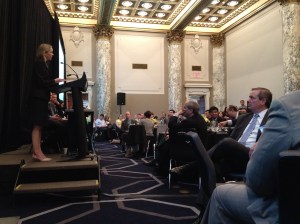City Department of Buildings Sustainability Chief Hails Energy Incentive
By Tobias Salinger June 5, 2014 3:28 pm
reprints

The head of the city Department of Buildings’ greening efforts heralded a massive efficiency payout for building owners in a speech this morning in front of energy industry insiders at a Con Edison Solutions forum.
Gina Bocra, the agency’s chief sustainability officer, hailed a Con Ed and New York State Energy Research and Development Authority incentive called the “demand response program” that presents building owners with big checks to go with their energy savings in exchange for cutting back on usage and installing new technology. The only catch is that owners have to install the fully-operational equipment by June 1, 2016.
“We’re very excited to help the market move forward with these technologies,” Ms. Bocra told the audience of approximately 100 energy business owners and property managers at the event at the W Hotel at Union Square sponsored by Con Ed Inc.’s deregulated subsidiary. She added, “For the first time ever, we’re ahead of Europe.”
The cash is for Con Ed customers who work out plans to use less energy on the summer’s hottest days and alter their HVAC units and energy storage systems, and the amount varies by which new equipment landlords install and the usage impact of the changes. But the owner of a 1.4-million-square-foot office building can get a payment for $300,000 this year for making alterations recommended by Con Ed Solutions, according to a hypothetical example circulated by the company to help explain the complex formula.
The extra cash would come in addition to energy bill savings and the environmental impact, which Ms. Bocra said can’t even be ballparked yet in a city with 1 million buildings that make up 80 percent of the city’s energy consumption.
“I’ve been surprised that there are a lot more users than we anticipated that can take advantage [of this],” Ms. Bocra said. “There’s potential for wide application. It’s very exciting but we don’t have a way to estimate what the impact will be.”


